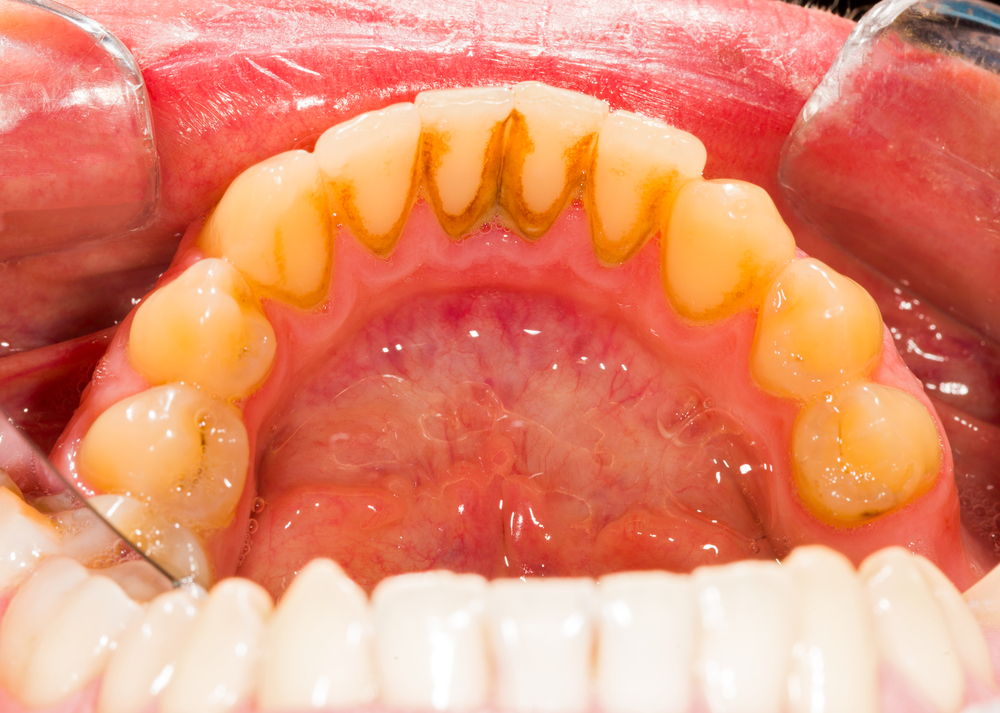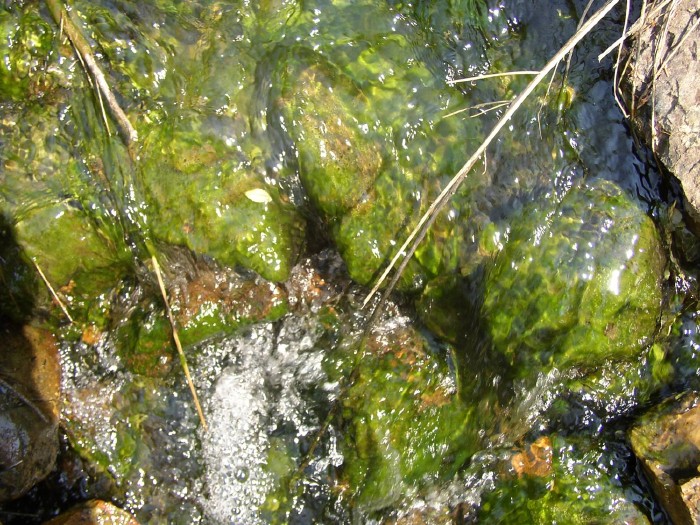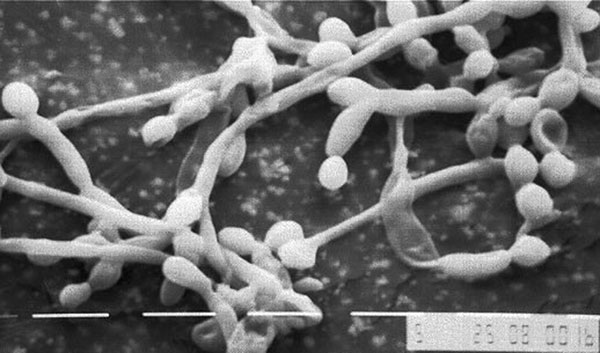What Are Biofilms?

Biofilms are a collective of one or more types of microorganisms that can grow on many different surfaces. Microorganisms that form biofilms include bacteria, fungi and protists.
One common example of a biofilm dental plaque, a slimy buildup of bacteria that forms on the surfaces of teeth. Pond scum is another example. Biofilms have been found growing on minerals and metals. They have been found underwater, underground and above the ground. They can grow on plant tissues and animal tissues, and on implanted medical devices such as catheters and pacemakers.
Each of these distinct surfaces has a common defining feature: they are wet. These environments are "periodically or continuously suffused with water," according to a 2007 article published in Microbe Magazine. Biofilms thrive upon moist or wet surfaces.
Biofilms have established themselves in such environments for a very long time. Fossil evidence of biofilms dates to about 3.25 billion years ago, according to a 2004 article published in the journal Nature Reviews Microbiology. For example, biofilms have been found in the 3.2 billion-year-old deep-sea hydrothermal rocks of the Pilbara Craton in Australia. Similar biofilms are found in hydrothermal environments such as hot springs and deep-sea vents.

Biofilm formation
Biofilm formation begins when free-floating microorganisms such as bacteria come in contact with an appropriate surface and begin to put down roots, so to speak. This first step of attachment occurs when the microorganisms produce a gooey substance known as an extracellular polymeric substance (EPS), according to the Center for Biofilm Engineering at Montana State University. An EPS is a network of sugars, proteins and nucleic acids (such as DNA). It enables the microorganisms in a biofilm to stick together.
Attachment is followed by a period of growth. Further layers of microorganisms and EPS build upon the first layers. Ultimately, they create a bulbous and complex 3D structure, according to the Center for Biofilm Engineering. Water channels crisscross biofilms and allow for the exchange of nutrients and waste products, according to the article in Microbe.
Multiple environmental conditions help determine the extent to which a biofilm grows. These factors also determine whether it is made of only a few layers of cells or significantly more. "It really depends on the biofilm," said Robin Gerlach, a professor in the department of chemical and biological engineering at Montana State University-Bozeman. For instance, microorganisms that produce a large amount of EPS can grow into fairly thick biofilms even if they do not have access to a lot of nutrients, he said. On the other hand, for microorganisms that depend on oxygen, the amount available can limit how much they can grow. Another environmental factor is the concept of "shear stress." "If you have a very high flow [of water] across a biofilm, like in a creek, the biofilm is usually fairly thin. If you have a biofilm in slow flowing water, like in a pond, it can become very thick," Gerlach explained.
Finally, the cells within a biofilm can leave the fold and establish themselves on a new surface. Either a clump of cells breaks away, or individual cells burst out of the biofilm and seek out a new home. This latter process is known as "seeding dispersal," according to the Center for Biofilm Engineering.
Why form a biofilm?
For microorganisms, living as a part of a biofilm comes with certain advantages. "Communities of microbes are usually more resilient to stress," Gerlach told Live Science. Potential stressors include the lack of water, high or low pH, or the presence of substances toxic to microorganisms such as antibiotics, antimicrobials or heavy metals.
There are many possible explanations for the hardiness of biofilms. For example, the slimy EPS covering can act as a protective barrier. It can help prevent dehydration or act as a shield against ultraviolet (UV) light. Also, harmful substances such as antimicrobials, bleach or metals are either bound or neutralized when they come into contact with the EPS. Thus, they are diluted to concentrations that aren't lethal well before they can reach various cells deep in the biofilm, according to a 2004 article in Nature Reviews Microbiology.
Still, it is possible for certain antibiotics to penetrate the EPS and make their way through a biofilm's layers. Here, another protective mechanism can come into play: the presence of bacteria that are physiologically dormant. In order to work well, all antibiotics require some level of cellular activity. So, if bacteria are physiologically dormant to begin with, there is not much for an antibiotic to disrupt.
Another mode of protection against antibiotics is the presence of special bacterial cells known as "persisters." Such bacteria do not divide and are resistant to many antibiotics. According to a 2010 article published in the journal Cold Spring Harbor Perspectives in Biology, "persisters" function by producing substances that block the targets of the antibiotics.
In general, microorganisms living together as a biofilm benefit from the presence of their various community members. Gerlach cited the example of autotrophic and heterotrophic microorganisms that live together in biofilms. Autotrophs, such as photosynthetic bacteria or algae, are able to produce their own food in the form of organic (carbon containing) material, while heterotrophs cannot produce their own food and require outside sources of carbon. "In these multi-organismal communities, they often cross feed," he said.
Biofilms and us
Given the vast range of environments in which we encounter biofilms, it is no surprise that they affect many aspects of human life. Below are a few examples.

Health and disease
As research has progressed over the years, biofilms — bacterial and fungal — have been implicated in a variety of health conditions. In a 2002 call for grant applications, the National Institutes of Health (NIH) noted that biofilms accounted "for over 80 percent of microbial infections in the body."
Biofilms can grow on implanted medical devices such as prosthetic heart valves, joint prosthetics, catheters and pacemakers. This in turn leads to infections. The phenomenon was first noted in the 1980s when bacterial biofilms were found on intravenous catheters and pacemakers. Bacterial biofilms have also been known to cause infective endocarditis and pneumonia in those with cystic fibrosis, according to the 2004 article in Nature Reviews Microbiology, among other infections.
"The reason that biofilm formation is a great cause of concern is that, within a biofilm, bacteria are more resistant to antibiotics and other major disinfectants that you could use to control them," said A.C. Matin, a professor of microbiology and immunology at Stanford University. In fact, when compared to free-floating bacteria, those growing as a biofilm can be up to 1,500 times more resistant to antibiotics and other biological and chemical agents, according to the article in Microbe. Matin described biofilm resistance combined with the general increase in antibiotic resistance among bacteria as a "double whammy" and a major challenge to treating infections.
Fungal biofilms can also cause infections by growing on implanted devices. Yeast species such as the members of the genus Candida grow on breast implants, pacemakers and prosthetic cardiac valves according to a 2014 article published in the journal Cold Spring Harbor Perspectives in Medicine. Candida species also grow on human body tissues, leading to diseases such as vaginitis (inflammation of the vagina) and oropharyngeal candidiasis (a yeast infection that develops in the mouth or throat). However, the authors note that drug resistance was not shown in these instances.
Bioremediation
Sometimes, biofilms are useful. "Bioremediation, in general, is the use of living organisms, or their products — for example, enzymes — to treat or degrade harmful compounds," Gerlach said. He noted that biofilms are used in treating wastewater, heavy metal contaminants such as chromate, explosives such as TNT and radioactive substances such as uranium. "Microbes can either degrade them, or change their mobility or their toxic state and therefore make them less harmful to the environment and to humans," he said.
Nitrification using biofilms is one form of wastewater treatment. During nitrification, ammonia is converted to nitrites and nitrates through oxidation. This can be done by autotrophic bacteria, which grow as biofilms on plastic surfaces, according to a 2013 article published in the journal Water Research. These plastic surfaces are just a few centimeters in size and distributed all through the water.
The explosive TNT (2,4,6-Trinitrotoluene) is considered a soil, surface water and groundwater pollutant. The chemical structure of TNT consists of benzene (a hexagonal aromatic ring made of six carbon atoms) attached to three nitro groups (NO2) and one methyl group (CH3). Microorganisms degrade TNT by reduction, according to a 2007 article published in the journal Applied and Environmental Microbiology. Most microorganisms reduce the three nitro groups, while some attack the aromatic ring. The researchers — Ayrat Ziganshin, Robin Gerlach and colleagues — found that the yeast strain Yarrowia lipolytica was able to degrade TNT by both methods, though primarily by attacking the aromatic ring.
Microbial fuel cells
Microbial fuel cells use bacteria to convert organic waste into electricity. The microbes live on the surface of an electrode and transfer electrons onto it, ultimately creating a current, Gerlach said. A 2011 article published in Illumin, an online magazine of the University of Southern California, notes that bacteria powering microbial fuel cells break down food and bodily wastes. This provides a low-cost source of power and clean sustainable energy.
Ongoing research
Our world is teeming with biofilms. In fact, by the mid-20th century, more bacteria were found on the inside surfaces of containers holding bacterial cultures, than floating freely in the liquid culture itself, according to the 2004 article in Nature Reviews Microbiology. Understanding these complex microbial structures is an active area of research.
"Biofilms are amazing communities. Some people have compared them to multicellular organisms because there is a lot of interaction between single cells," Gerlach said. "We are continuing to learn about them, and we are continuing to learn about how to control them better; both for reduced detriment, as in the field of medicine, or for increased benefit as in bioremediation. We are not going to run out of interesting questions in that area."
Additional resources
Sign up for the Live Science daily newsletter now
Get the world’s most fascinating discoveries delivered straight to your inbox.
Aparna Vidyasagar is a freelance science journalist who specializes in health and life sciences. Aparna has written for a number of publications, including New Scientist, Science, PBS SoCal, Mental Floss, and several others. Aparna has a doctorate in Cellular and Molecular Pathology from the University of Wisconsin-Madison, and also received a master’s degree and bachelor’s degree from the same university.










